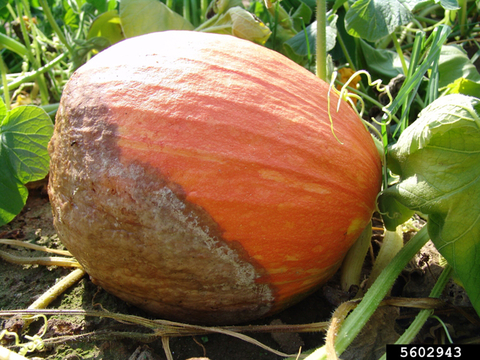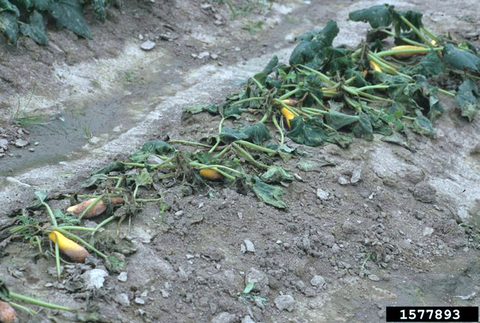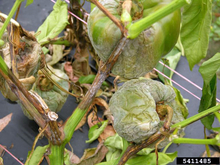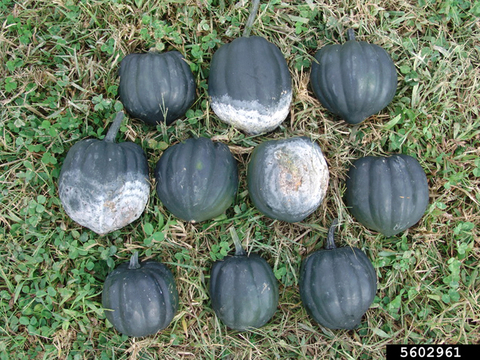Quick facts
- Phytophthora (Phytophthora capisci) can infect all cucurbits (pumpkins, squash, melons, etc.) as well as peppers, tomatoes, eggplants and beans. A different type of phytophthora infects raspberries and strawberries.
- Phytophthora is long-lived in the soil and driven by moisture.
- Disease can infect all parts of the plant tissue, and the most apparent symptom is wilting and white, powdered sugar-like spores on infected plant tissue.
- Disease is very hard to manage once present in a field, so focus on prevention.
- Phytophthora travels through water. Plant in well-drained fields and use raised beds to improve drainage. Avoid working in wet, impacted fields.
- Rotate out of cucurbit and solanaceous crops for a minimum of three years.
- Phytophthora is not common in Minnesota home gardens.
How to tell phytophthora from other vegetable issues
- Infections are often first noticed as a cluster of wilting and collapsed plants.
- Plants pull up easily from the soil due to root loss.
- Infected roots and crown look black and water-soaked.
- White growth that looks like powdered sugar covers infected fruit and crowns.
- Stem and leaf petiole lesions are light to dark brown, water-soaked, and irregular.
- Severe infections result in plants with large irregular brown spots forming on leaves before plants collapse.
- Fruit develops soft, water-soaked rot.
- Infection may start where the fruit contacts the soil, where the stem connects to the fruit, or as a random circular spot.
- Infected fruit are soft, easily punctured and often collapse.
- In some cases, infection on the fruit can show up after harvest.
- Because phytophthora is long-lived and requires intensive management, suspected infections should be sent to the UMN Plant Disease Clinic.
Biology
- Phytophthora capisci is a pathogen that can infect all cucurbit crops as well as peppers, tomatoes, eggplants and beans. Infection is most common in zucchini, squash, pumpkin, and pepper.
- Phytophthora infects every part of the plant including roots, crowns, leaves, vines and fruit.
- Phytophthora thrives in warm (75-85° F), wet conditions.
- Disease is more common in low-lying, poorly drained areas of the field, but can spread throughout the field if environmental conditions are right.
- Spores can travel on soil stuck to equipment used in an infested area and on windblown raindrops.
- Phytophthora overwinters in soil and plant debris.
- Phytophthora capsici is an oomycete, also known as a water mold. Oomycetes are not true fungi but are close relatives to certain kinds of algae.
- Phytophthora has swimming spores known as zoospores that can swim through films of water and saturated soils to locate a new host plant. As a result, new infections often appear in the direction in which water drainage occurs.
- There are two different mating types of Phytophthora capsici.
- If only one mating type is present in a field, the pathogen can survive for two years.
- If both mating types are present, the fungus will create oospores, a hard-walled resting structure that can survive five or more years.
- It is unknown if both mating types occur in Minnesota.
Managing phytophthora on farms
- As phytophthora is water-driven, when scouting, pay special attention to low spots and fields irritated with surface water.
- Phytophthora has been documented moving from farm to farm and field to field in river water.
- Keep an eye out for collapsed plants and powdered sugar spores in these areas.
There are a limited number of varieties with some level of phytophthora tolerance. See Cornell’s Disease Resistant Vegetable Varieties for a round-up of resistant varieties by crop.
- If the farm has no history of phytophthora, prevention is the goal. Irrigate from wells rather than surface water if possible.
- After discovering phytophthora infection in a field, the goal is to remove the disease-carrying plants and deplete the disease population in that field before planting a susceptible crop again. This process takes several years.
- Avoid planting susceptible crops in fields with a history of this disease.
- Plant in well-drained fields. Use raised beds to improve drainage.
- Do not work in fields when soils are wet, to avoid compacting the soil.
- Rotate out of cucurbit and solanaceous crops for a minimum of three years.
- Remove infected plants as well as neighboring plants that appear healthy, as they are likely infected as well. Dispose of plants outside of production areas.
- In large fields where a small area of infected plants has appeared, till in this area and a border of healthy plants. This will help reduce the number of phytophthora spores being produced over the course of the season. Thoroughly clean equipment afterward.
- Clean tools and equipment (including tractor wheels) after working with phytophthora-infected plants. The goal is to remove clumps of dirt that can harbor phytophthora, before using the tools in another field.
- Do not harvest normal-appearing fruit from phytophthora-infested areas, as they are likely infected, will break down quickly, and result in fruit-to-fruit contamination that can be spread to other fields. Keep them separate from fruit harvested from other areas of the field.
- Do not put diseased fruit or plants in cull piles in production fields. Instead, remove infected plants and put them in cull piles far from the production fields.
- If neighboring farms have phytophthora, avoid planting cucurbits and peppers in fields nearby, or where water might drain from neighboring fields.
As phytophthora is not a true fungus, products used to slow phytophthora are specific to water molds. Application advice varies by product and by crop being protected, as different parts of different plants vary in their susceptibility to phytophthora.
Michigan State and Cornell have active phytophthora research programs and produce current crop-specific product recommendations.
Note that phytophthora has been documented to develop resistance to mefenoxam and metalaxyl.
Refer to the Midwest Vegetable Production Guide for specific pesticide recommendations.
CAUTION: Mention of a pesticide or use of a pesticide label is for educational purposes only. Always follow the pesticide label directions attached to the pesticide container you are using. Be sure that the area you wish to treat is listed on the label of the pesticide you intend to use. Remember, the label is the law.
Phytophthora in home gardens
Correctly identify vegetable issues
Phytophthora is one of many soilborne pathogens and is not common in Minnesota gardens. You can use Ask a Master Gardener for help figuring out what is going on in your garden.
Cultural controls
Rotate different vegetable families into new areas of the garden on at least a three-year schedule.
Reviewed in 2024







